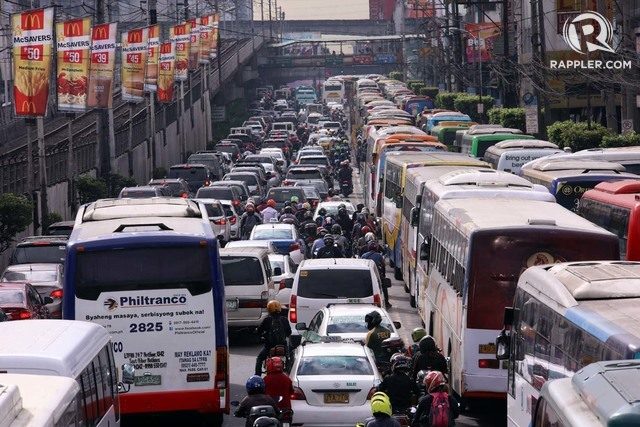SUMMARY
This is AI generated summarization, which may have errors. For context, always refer to the full article.

MANILA, Philippines (3rd UPDATE) – Anyone who faces the daily commute in Metro Manila is no stranger to hours of traffic and unpredictability.
Between the complaints of commuters, motorists, and transport operators and the debates and hearings done by policy makers, the proposed solution that always stands out is the improvement of the mass transport system.
What is the state of mass transit in the National Capital Region (NCR) to begin with?
Land motor vehicles
A 2019 Asian Development Bank (ADB) study reported that Metro Manila is the “most congested city“ out of 278 cities in developing Asia.
As of August 2019, the Land Transportation Office reported that the National Capital Region accounted for the largest number of registered motor vehicles at 1,644,932. Coming second is its neighboring Region IV-A, with 880,168. These two alone account for almost 40% of the total 6,783,696 registered vehicles nationwide.
In 2018, the Metropolitan Manila Development Authority (MMDA) reported that the average daily volume of cars passing EDSA was 251,628, dwarfing public utility buses that averaged 13,356.
Public utility buses comprised only 3% of total traffic along EDSA in 2017. Private cars took up 67% of road space. However, that did not stop the MMDA from implementing a provincial bus ban dry run last August.
Trains
Metro Manila has 4 operational railway systems: Light Rail Transit (LRT) lines 1 and 2, the Metro Rail Transit 3 (MRT), and the Philippine National Railways (PNR).
LRT1 has been operational for 35 years; MRT, 20 years; and LRT2, 16 years. Meanwhile, the PNR first began operations in 1891 – far back enough to see Jose Rizal’s completion of El Filibusterismo.
Some of the train cars being deployed today have been there since they first opened.
In 2017, there were 516 MRT problems recorded – almost 10 a week. Of this number, 449 were offloading incidents, where passengers had to alight the trains and walk along MRT tracks. (READ: MRT woes: How often do they happen?)
In early 2018, the MRT suffered almost daily breakdowns.
China-made Dalian trains, which were meant to replace the old MRT cars, have been in the Philippines since 2016. To this day, they have yet to be put to operation. Incompatibility issues have been cited as the cause of the delay in their deployment.
The PNR has been known to cancel trips without prior notification to the public. Many of the canceled trips are along the Tutuban-Alabang-Tutuban route, the most in-demand of all. (READ: Poor National Railways? Thousands suffer as PNR cancels 713 trips in only 2 months)
Data from the Department of Transportation show that an average of 276,128 passengers board the MRT every day.
Meanwhile, the PNR had more than a million passengers in January this year.
Train authorities have set policies allowing free rides for students. Stations are also compelled to allot special cars or lanes for women, students, persons-with-disabilities (PWDs), elderly passengers, and pregnant women.
Corruption?
The Land Transportation Franchising and Regulatory Board is hounded by reports of corruption in granting franchises. Liaison officers at companies looking to acquire a franchise reportedly resort to bribery to hasten the process – allegations that the LTFRB has denied. (READ: Corruption at LTO, LTFRB: Unfit drivers, vehicles on the road)
In 2014, availing services from a fixer to get a driver’s license at the Land Transportation Office would cost around P2,500. Part of the fare would be split among the employees in connivance with them. (READ: The fixing business at LTO)
Root problems, economic costs
A 2012 ADB study identified the main challenges the Philippine transportation faced:
- Poor quality of road network
- Poor intermodal integration
- Weak sector governance and institutional capacity
- Lack of quality urban transport systems
- Limited private investment in transport infrastructure
In 2014, a Japan International Cooperation Agency (JICA) study projected the economic cost of traffic in Metro Manila to reach up to P6 billion daily by 2030 – if the situation continues.
In 2018, the House of Representatives passed a bill seeking to grant emergency powers to the DOTr secretary to address the urban traffic problem. No counterpart measure prospered in the Senate. DOTr withdrew its request, made on behalf of President Rodrigo Duterte, last September 23.
Commuters’ voices
The advocacy group AltMobility has lobbied for a law protecting commuters’ rights. The Senate and House versions of the bills have been pending in Congress since July 2019.
According to the bill’s explanatory note, commuters comprise 70% of total trips in Metro Manila, but only 20% road space is allocated for them. – with reports from GM Castro/Rappler.com
Add a comment
How does this make you feel?





There are no comments yet. Add your comment to start the conversation.